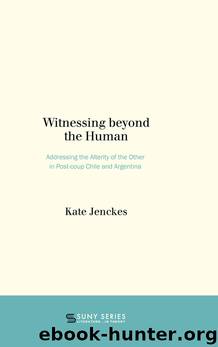Witnessing Beyond the Human by Kate Jenckes

Author:Kate Jenckes
Language: eng
Format: epub
Publisher: State University of New York Press
Published: 2017-06-20T16:00:00+00:00
■ 4 ■
Image and Alterity Beyond the Sepulture of the Human
Eugenio Dittborn’s Photocollages
Exhumation will produce a definitive disappearance.
—Willy Thayer
All that heavy and pathetic humanity remains suspended …
—Pablo Oyarzún
I invented these folded paintings to get out from this place, to be in the world. … They are like messages in a bottle.
—Eugenio Dittborn
Nelly Richard describes how the legacy of the Chilean dictatorship is perhaps best conveyed by the image of the unburied remains of the desaparecidos—“The image of their unfound and unburied remains (sin hallar, sin sepultar)” (La insubordinación de los signos 13). This is because the desaparecidos represent a challenge to humanist modalities of representation and emplacement: how (human) life and death are situated in understanding and thereby contained. The imposed placelessness of the desaparecidos is on the one hand an extreme instance of emplacement, a condition of subjugation and sacrifice to the despotic conception of the patria. The remnants of the sacrifice, however, remain at large, without sepulture. This emplacement that ends in placelessness can be countered by trying to find them a place, a “A capitalized Name in which to rest” (Marchant, “Amor de la foto” 13).1 Or the placelessness can be acknowledged, along with the unresolvable tensions it evokes, including “recuerdo y olvido, … latencia y muerte, revelación y ocultamiento, prueba y denegación, sustracción y restitución” (Insubordinación 13).
This chapter considers the ways in which humanist emplacement is challenged in visual representation, primarily photography and the photocollages of Eugenio Dittborn. Richard, along with a number of other critics, notes that photography became a privileged medium to address the issue of disappearance during the 1970s, and galvanized debates about the nature of representation among artists and thinkers during the dictatorship (Insubordinación 19). On the one hand, photography served an important documentary function, revealing the effects of clandestine violence in opposition to the dictatorship’s sanitized accounts of social order and economic progress. As important as this visual activism was, it often overlooked epistemological tensions in the interest of political efficacy, affirming photography’s capacities for revelation, proof, and restitution, its frame serving as a humanistic home for the “memory and forgetting, latency and death, … revelation and concealment, proof and denial, elimination and restitution,” in which Dittborn figured prominently, probed the epistemological and ethical complexities of photographic representation, resisting the sense of it as a site of revelation and recuperation of what was destroyed and buried by the dictatorship. Richard affirms that this interrogation was concerned with a sense of “historical mourning,” understood not only as a relationship to the past or to individual deaths and disappearances, but to totalizing paradigms of history, truth, and national or ideological commonality (Insubordinación 13).2 She describes this work of mourning as an unending and inconclusive acknowledgment of the present’s vulnerability to all that does not fit into an integral sense of national presence. In what follows I will explore this sense of historical mourning, stressing its engagement with the historical or finite nature of every relationship, including, quintessentially, the relationships between self and other, and (prior) presence and representation.
Download
This site does not store any files on its server. We only index and link to content provided by other sites. Please contact the content providers to delete copyright contents if any and email us, we'll remove relevant links or contents immediately.
4 3 2 1: A Novel by Paul Auster(11823)
The handmaid's tale by Margaret Atwood(7471)
Giovanni's Room by James Baldwin(6831)
Asking the Right Questions: A Guide to Critical Thinking by M. Neil Browne & Stuart M. Keeley(5371)
Big Magic: Creative Living Beyond Fear by Elizabeth Gilbert(5364)
Ego Is the Enemy by Ryan Holiday(4972)
On Writing A Memoir of the Craft by Stephen King(4677)
The Body: A Guide for Occupants by Bill Bryson(4603)
Ken Follett - World without end by Ken Follett(4455)
Bluets by Maggie Nelson(4284)
Adulting by Kelly Williams Brown(4246)
Eat That Frog! by Brian Tracy(4171)
Guilty Pleasures by Laurell K Hamilton(4129)
White Noise - A Novel by Don DeLillo(3838)
The Poetry of Pablo Neruda by Pablo Neruda(3828)
Fingerprints of the Gods by Graham Hancock(3749)
Alive: The Story of the Andes Survivors by Piers Paul Read(3744)
The Book of Joy by Dalai Lama(3714)
The Bookshop by Penelope Fitzgerald(3629)
